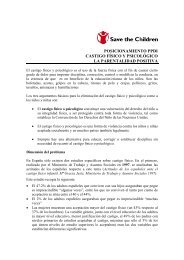Nutrition in the First 1,000 Days - Save the Children
Nutrition in the First 1,000 Days - Save the Children
Nutrition in the First 1,000 Days - Save the Children
Create successful ePaper yourself
Turn your PDF publications into a flip-book with our unique Google optimized e-Paper software.
8 executive summary<br />
afghanistan<br />
workers, <strong>in</strong>clud<strong>in</strong>g community health workers, who are critical to deliver<strong>in</strong>g<br />
<strong>the</strong> nutrition solutions that can save lives and prevent stunt<strong>in</strong>g. Governments<br />
and donors should work toge<strong>the</strong>r to fill this health worker gap by recruit<strong>in</strong>g,<br />
tra<strong>in</strong><strong>in</strong>g and support<strong>in</strong>g new and exist<strong>in</strong>g health workers, and deploy<strong>in</strong>g <strong>the</strong>m<br />
where <strong>the</strong>y are needed most.<br />
3. Help more girls go to school and stay <strong>in</strong> school. One of <strong>the</strong> most effective<br />
ways to fight child malnutrition is to focus on girls’ education. Educated women<br />
tend to have fewer, healthier and better-nourished children. Increased <strong>in</strong>vestments<br />
are needed to help more girls go to school and stay <strong>in</strong> school, and to encourage<br />
families and communities to value <strong>the</strong> education of girls. Both formal education<br />
and non-formal tra<strong>in</strong><strong>in</strong>g give girls knowledge, self-confidence, practical skills and<br />
hope for a bright future. These are powerful tools that can help delay marriage<br />
and child-bear<strong>in</strong>g to a time that is healthier for <strong>the</strong>m and <strong>the</strong>ir babies.<br />
4. Increase government support for proven solutions to fight malnutrition<br />
and save lives. In order to meet <strong>in</strong>ternationally agreed upon development goals<br />
to reduce child deaths and improve mo<strong>the</strong>rs’ health, lifesav<strong>in</strong>g services must<br />
be <strong>in</strong>creased for <strong>the</strong> women and children who need help most. All countries<br />
must make fight<strong>in</strong>g malnutrition and stunt<strong>in</strong>g a priority. Develop<strong>in</strong>g countries<br />
should commit to and fund national nutrition plans that are <strong>in</strong>tegrated with<br />
plans for maternal and child health. Donor countries should support <strong>the</strong>se<br />
goals by keep<strong>in</strong>g <strong>the</strong>ir fund<strong>in</strong>g commitments to achiev<strong>in</strong>g <strong>the</strong> Millennium<br />
Development Goals and countries should endorse and support <strong>the</strong> Scal<strong>in</strong>g Up<br />
<strong>Nutrition</strong> (SUN) movement. Resources for malnutrition programs should not<br />
come at <strong>the</strong> expense of o<strong>the</strong>r programs critical to <strong>the</strong> survival and well-be<strong>in</strong>g<br />
of children.(To read more, turn to page 45.)<br />
5. Increase private sector partnerships to improve nutrition for mo<strong>the</strong>rs and<br />
children. Many local diets fail to meet <strong>the</strong> nutritional requirements of children 6-24<br />
months old. The private sector can help by produc<strong>in</strong>g and market<strong>in</strong>g affordable<br />
fortified products. Partnerships should be established with multiple manufacturers,<br />
distributors and government m<strong>in</strong>istries to <strong>in</strong>crease product choice, access and<br />
affordability, improve compliance with codes and standards, and promote public<br />
education on good feed<strong>in</strong>g practices and use of local foods and commercial products.<br />
The food <strong>in</strong>dustry can also <strong>in</strong>vest more <strong>in</strong> nutrition programs and research,<br />
contribute social market<strong>in</strong>g expertise to promote healthy behaviors such as breastfeed<strong>in</strong>g,<br />
and advocate for greater government <strong>in</strong>vestments <strong>in</strong> nutrition.<br />
6. Improve laws, policies and actions that support families and encourage<br />
breastfeed<strong>in</strong>g. Governments <strong>in</strong> all countries can do more to help parents and<br />
create a supportive environment for breastfeed<strong>in</strong>g. Governments and partners<br />
should adopt policies that are child-friendly and support breastfeed<strong>in</strong>g<br />
mo<strong>the</strong>rs. Such policies would give families access to maternal and paternal<br />
leave, ensure that workplaces and public facilities offer women a suitable<br />
place to feed <strong>the</strong>ir babies outside of <strong>the</strong> home, and ensure work<strong>in</strong>g women<br />
are guaranteed breastfeed<strong>in</strong>g breaks while on <strong>the</strong> job. In an <strong>in</strong>creas<strong>in</strong>gly urban<br />
world, a fur<strong>the</strong>r example is that public transportation can offer special seats<br />
for breastfeed<strong>in</strong>g mo<strong>the</strong>rs.

















